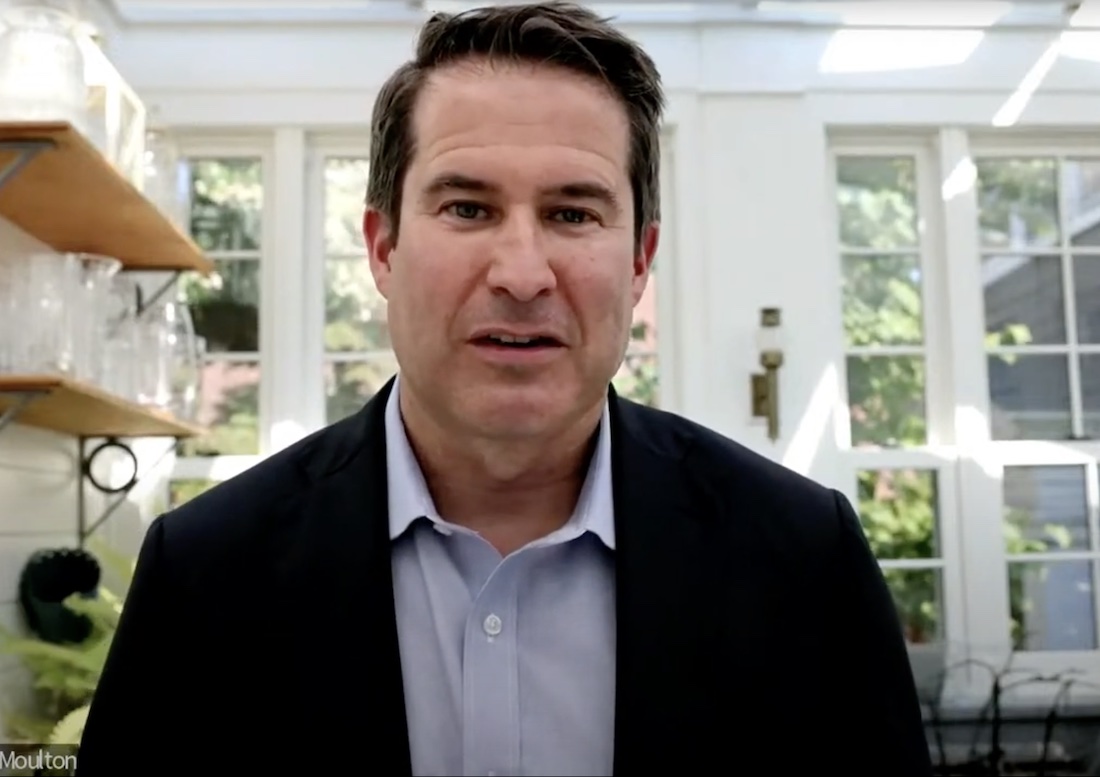Originally posted on the High Speed Rail Alliance Blog
 Picture Right: Rep. Seth Moulton (D-MA) spoke eloquently about the importance of investing in high-speed rail during the markup on September 14th.
Picture Right: Rep. Seth Moulton (D-MA) spoke eloquently about the importance of investing in high-speed rail during the markup on September 14th.
On Tuesday, after a more than 15 hour markup, the House Transportation & Infrastructure Committee advanced legislation that includes a record $10 billion in dedicated funding for high-speed rail. The funding was part of a broader overall package of $60 billion in proposed investments in making America’s infrastructure “more sustainable, resilient, and equitable, and to reduce carbon pollution from the transportation sector.”
The funding for HSR is split into two pots: $9 billion for capital projects and $1 billion for planning costs. It will be awarded through a competitive grant process over the next 5 years. Projects like California HSR should be able to move quickly to secure funding for capital projects and work towards getting 220 mph trains in operation by the end of the decade.
The billion set aside for planning can go a long way towards getting HSR projects around the country ready to break ground. The Midwest and Southeast are especially prepared to take advantage of this funding for projects like Atlanta to Charlotte, Atlanta to Dallas and the foundation for a Midwest network.
Although the funding would have broad national impacts, California’s high-speed rail project—which will provide a single-seat ride from San Francisco to L.A. in under 3 hours—took center stage in the committee’s debate.
That’s partly because it stands to benefit immensely from not just the $10 billion in dedicated HSR funding but from several other potential funding streams.
For example, the bill includes $10 billion to “support access to affordable housing and enhance mobility for low-income individuals”; $4 billion to slash carbon pollution in the surface-transportation sector; and $4 billion to support affordable transportation access.
HSR is key to achieving all of those goals.
A spokeswoman for the California High-Speed Rail Authority, Melissa Figueroa, noted that the legislation contains between $20 and $30 billion in grants that the project is eligible to compete for—and “that’s what we intend to do,” she said. “This is a once-in-a-lifetime investment in rail.”
In addition to providing historic levels of funding for HSR, the bill redefines HSR projects to mean trains that reach speeds of 160+ mph on existing tracks or 186+ mph on new, dedicated tracks. Past funding for HSR in the US has been spent on projects that reach 110+ mph for shared-use tracks and 125+ mph for dedicated lines.
HSR’s Competitive Advantages
The committee’s markup session contained spirited debate over high-speed trains, as advocates for HSR in the House voted down amendments designed to kill funding for HSR. (View the video here.)
Rep. Seth Moulton (D-MA)—who has authored a bill that would invest $205 billion in a national HSR network—mounted an aggressive defense of both the California project and high-speed trains generally. (Watch Moulton’s comments here)
“It’s interesting that there’s no issue with giving federal money to roads, no issue with giving federal money to the airlines,” Moulton said. “We have this crazy standard for high-speed rail, that it should be entirely supported by the private sector when none of its competition is at all.
“In fact, if you really look at the cost of roads, you have to figure in the emergency vehicles, state police—literally the cost of tens of thousands of deaths on our highways every year—if you really want to understand the full cost of that mode of transportation.”
According to one recent estimate, every dollar that a driver spends is subsidized with $10 in public subsidies—versus $1.50 for public transit.
In advocating for the California project specifically, Moulton noted that the San Francisco to L.A. line would offer much more frequent—and affordable—service than the airlines.
“You only have a few flights a day to San Francisco [from the Orange County Airport, south of L.A],” Moulton said. “With this line completed, you’ll have trains about every 20 minutes. That’s a huge difference in service frequency—not just in price but in frequency and affordability and convenience—for all the people of Orange County and other communities that will be served on intermediate stops along this new high-speed rail line.”
But Can it Pass?
The fate of the legislation—and its funding for high-speed trains—remains to be seen. Some moderate Democrats in both the House and Senate have balked at the $3.5 trillion in overall investments proposed in the Senate’s “reconciliation” bill. The legislation passed by the T&I Committee on Tuesday is part of a bigger bill that the House is writing to mirror the Senate’s spending priorities.
So, the $10 billion in dedicated funding for HSR could be reduced—or eliminated altogether—as details of the Senate’s reconciliation bill are negotiated over the coming weeks. Or the bill could fail to pass Congress altogether.
You can make a big difference in the outcome. In fact, your actions will never have a bigger impact on the future of HSR in the U.S. than they will right now.
Please take a moment and contact your representatives. (Keep in mind that calls have an especially big impact.)
Tell them that it’s time for the U.S. to build a transportation system that’s up to the challenges of the twenty-first century—which is why you support the maximum amount possible for high-speed trains in the legislation-writing that’s happening in Congress right now.
View original (hsrail.org): https://hsrail.org/blog/house-ti-committee-advances-10-billion-hsr






 RSS Feed
RSS Feed